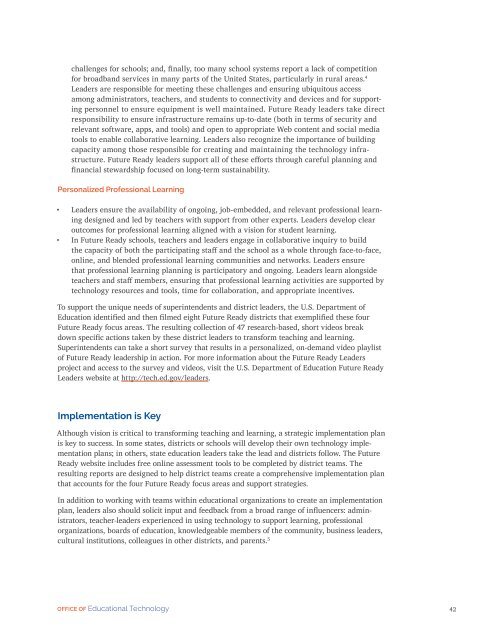Future Ready Learning
7m3sdJ
7m3sdJ
Create successful ePaper yourself
Turn your PDF publications into a flip-book with our unique Google optimized e-Paper software.
challenges for schools; and, finally, too many school systems report a lack of competition<br />
for broadband services in many parts of the United States, particularly in rural areas. 4<br />
Leaders are responsible for meeting these challenges and ensuring ubiquitous access<br />
among administrators, teachers, and students to connectivity and devices and for supporting<br />
personnel to ensure equipment is well maintained. <strong>Future</strong> <strong>Ready</strong> leaders take direct<br />
responsibility to ensure infrastructure remains up-to-date (both in terms of security and<br />
relevant software, apps, and tools) and open to appropriate Web content and social media<br />
tools to enable collaborative learning. Leaders also recognize the importance of building<br />
capacity among those responsible for creating and maintaining the technology infrastructure.<br />
<strong>Future</strong> <strong>Ready</strong> leaders support all of these efforts through careful planning and<br />
financial stewardship focused on long-term sustainability.<br />
Personalized Professional <strong>Learning</strong><br />
• Leaders ensure the availability of ongoing, job-embedded, and relevant professional learning<br />
designed and led by teachers with support from other experts. Leaders develop clear<br />
outcomes for professional learning aligned with a vision for student learning.<br />
• In <strong>Future</strong> <strong>Ready</strong> schools, teachers and leaders engage in collaborative inquiry to build<br />
the capacity of both the participating staff and the school as a whole through face-to-face,<br />
online, and blended professional learning communities and networks. Leaders ensure<br />
that professional learning planning is participatory and ongoing. Leaders learn alongside<br />
teachers and staff members, ensuring that professional learning activities are supported by<br />
technology resources and tools, time for collaboration, and appropriate incentives.<br />
To support the unique needs of superintendents and district leaders, the U.S. Department of<br />
Education identified and then filmed eight <strong>Future</strong> <strong>Ready</strong> districts that exemplified these four<br />
<strong>Future</strong> <strong>Ready</strong> focus areas. The resulting collection of 47 research-based, short videos break<br />
down specific actions taken by these district leaders to transform teaching and learning.<br />
Superintendents can take a short survey that results in a personalized, on-demand video playlist<br />
of <strong>Future</strong> <strong>Ready</strong> leadership in action. For more information about the <strong>Future</strong> <strong>Ready</strong> Leaders<br />
project and access to the survey and videos, visit the U.S. Department of Education <strong>Future</strong> <strong>Ready</strong><br />
Leaders website at http://tech.ed.gov/leaders.<br />
Implementation is Key<br />
Although vision is critical to transforming teaching and learning, a strategic implementation plan<br />
is key to success. In some states, districts or schools will develop their own technology implementation<br />
plans; in others, state education leaders take the lead and districts follow. The <strong>Future</strong><br />
<strong>Ready</strong> website includes free online assessment tools to be completed by district teams. The<br />
resulting reports are designed to help district teams create a comprehensive implementation plan<br />
that accounts for the four <strong>Future</strong> <strong>Ready</strong> focus areas and support strategies.<br />
In addition to working with teams within educational organizations to create an implementation<br />
plan, leaders also should solicit input and feedback from a broad range of influencers: administrators,<br />
teacher-leaders experienced in using technology to support learning, professional<br />
organizations, boards of education, knowledgeable members of the community, business leaders,<br />
cultural institutions, colleagues in other districts, and parents. 5<br />
OFFICE OF Educational Technology<br />
42



